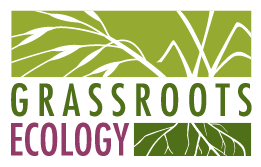Partnerships in Conservation: POST and Grassroots Ecology
Grassroots Ecology cares for thousands of acres of land from the Santa Cruz Mountains to the San Francisco Bay, but we couldn't do it without those who protect this region from development. Peninsula Open Space Trust (POST) is doing exactly that – creating a network of protected lands where people and nature connect and thrive.
POST and Grassroots Ecology have partnered to host community volunteer events for three years now, providing opportunities for locals to volunteer outside and positively impact the land.
The equation is simple: much of the land we are able to steward was held in conservation thanks to POST. And the communities that sustain these restoration projects are those who sustain healthy ecosystems. Investing in one is investing in the other!
Much of POST’s work is focused on increasing connectivity in our open spaces. While fragmented habitats threaten wildlife species diversity and survival, connected lands keep humans and wildlife safe. POST has been an integral part of regional efforts to reconnect habitat along the bayshore and in the foothills of the Santa Cruz mountains – the same places that Grassroots Ecology restores by reintroducing native plants and removing invasive species.
Cooley Landing
In 1999, POST acquired a parcel of shoreline in East Palo Alto that had been used as a landfill for 30 years. That site was transferred to the City of East Palo Alto in 2006; today the site is a popular public park that is completely transformed from the dump site it once was.
Grassroots Ecology has been working at Cooley Landing since 2012, restoring areas along the park’s trails and near to bring native upland habitat to a stretch of bare land left after the dump was covered over.
Both organizations are also involved in protecting and restoring Ravenswood Open Space Preserve adjacent to Cooley Landing. This preserve was acquired by POST and transferred to Midpeninsula Regional Open Space District. Our work at Ravenswood is focused on marsh-upland transition zone habitat along the Bay Trail.
People power continues to reign true at Cooley Landing: volunteers install native plants to support local biodiversity.
Suppressing invasive weeds with cardboard and mulch at Shoreline at Mountain View supports a rich wildlife corridor connected to POST-protected Crittenden Marsh.
Shoreline at Mountain View
POST works to protect critical bayshore habitat all along the peninsula, including Crittenden Marsh at the southern end of the Bay. Crittenden Marsh was donated in 1980 to POST, who transferred it to the Midpeninsula Regional Open Space District. It provides habitat for endangered species like the Ridgway’s Rail and salt marsh harvest mouse.
Grassroots Ecology is currently working at Shoreline Park, adjacent to Crittenden Marsh, to restore the marsh-upland transition zone along the Bay Trail and Permanente Creek. By conserving and restoring land along the shoreline, Grassroots Ecology and POST connect people to the critical ecosystems that help make us resilient to sea level rise and enrich our lives.
Redwood Creek
Redwood Creek flows through Redwood City and empties into the Bay near Bair Island. Now protected as part of the Don Edwards San Francisco Bay National Wildlife Refuge, Bair Island was once threatened by development. After community efforts to protect the land through advocacy and voting, POST was able to buy the property from its private owners in 1977, then transferred it to the US Fish and Wildlife Service.
Grassroots Ecology's restoration work along Redwood Creek directly impacts Bair Island: volunteers can witness firsthand how the changing tide draws trash and debris downstream to the island. We reintroduce native plants, remove invasive species, and remove trash along Redwood Creek to sustain nearby human communities and the wild residents of Bair Island.
Removing trash to steward the ecosystem along Redwood Creek connects us to the positive impact one can have on watersheds (like the one POST had, protecting nearby Bair Island!).
Thanks to POST’s efforts at Pearson-Arastradero Preserve, previously fragmented habitats can be reconnected—with support from local youth who install a diversity of native plants.
Pearson-Arastradero Preserve
Pearson-Arastradero Preserve was dedicated as park land in 1981, but a 13-acre parcel in the middle of the preserve remained in private hands for years. POST purchased that property in 2002 for $3.56 million, thereby protecting the land from luxury residential development, ensuring it would remain in public hands in perpetuity, and reconnecting fragmented habitat.
Arastradero Preserve is Grassroots Ecology’s founding restoration project: we have worked there since 1997 to improve habitat for the benefit of people and wildlife.
We believe everyone has a role to play in realizing our vision of vibrant, healthy lands and human communities that support one another. Thank you to POST for your passion in bringing the community together for amazing and accessible events.
We hope to see you at one of our co-created events soon!
By Valerie Lee, Director of Community Engagement






